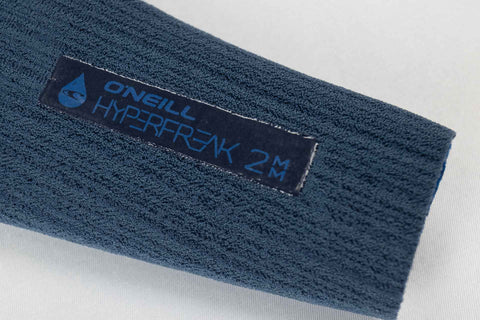Wetsuit thickness affects both warmth and flexibility and is measured in Millimeters or “mm” for short. You will often see wetsuits listed with numbers like 3/2 or 4/3 in the title, but “mm” or millimeters is nowhere in sight. This is the industry standard, and it is safe to assume that numbers like 4/3 refer to the thickness of the suit. So when a wetsuit is referred to as a 4/3, this means it is 4mm in certain areas and 3mm in others. It may not be clear exactly which part of the suit is what thickness, but generally, you will find the body to be the thickest, then the legs a little thinner, and the arms will typically be the thinnest to maximize flexibility.




WETSUIT THICKNESS TEMPERATURE CHART*
| Water Temperature Range (°F) | Wetsuit Thickness | Wetsuit Type |
|---|---|---|
| 75° and up | n/a | Board shorts, Jacket, and/or Shorts |
| 65° to 75° | 3/2mm or 2mm | Fullsuit or Spring Suit |
| 62° to 68° | 3/2mm or 2mm | Fullsuit or Spring Suit |
| 58° to 63° | 3/2mm or 4/3mm | Fullsuit or Hooded Fullsuit |
| 52° to 58° | 4/3mm or 5/4/3mm | Fullsuit or Hooded Fullsuit |
| 43° to 52° | 5/4/3mm or 6/5/4mm | Hooded Fullsuit |
| 42° and below | 6/5/4mm | Hooded Fullsuit |
*The above chart is simply a guide based on what we think the average person in average conditions would wear. Personal preferences, along with the air temperature and weather conditions (wind/rain/snow), will play a role as well.
How does a wetsuits thickness affect flexibility?
Thickness has a big impact on the flexibility of a wetsuit. Assuming the same neoprene is used, the thicker the suit, the less flexible it is going to be, so if you are used to wearing a 3/2 and then you go on a trip to somewhere that you need a 5/4/3, you will find it a lot more resistant to your movement.
How does a wetsuits thickness affect warmth?
It’s fairly simple: the thicker the wetsuit, the warmer you will be. A 5/4/3 wetsuit will be much warmer than a 3/2 wetsuit.
How does a wetsuits thickness affect durability?
Thickness plays a small role in the durability of a wetsuit. Thicker suits, having more material, are less prone to getting tears all the way through the neoprene. This is really minor. Unless you scrape your wetsuit on barnacles or cut through it with your fin, wearing through your neoprene takes years, and most other parts of the wetsuit will fail long before that happens.
How does a wetsuits thickness affect fit?
The thickness of a wetsuit does have a small influence on your fit. Thicker neoprene can make a suit seem smaller, mainly because thicker suits are generally a bit less flexible. In rare situations, this can cause people to prefer a bigger size in thicker suits, even if it is the same model as a thinner wetsuit they already have.
